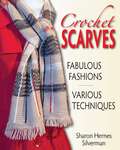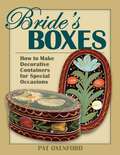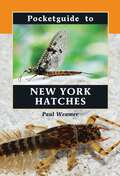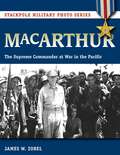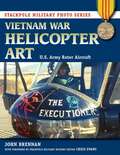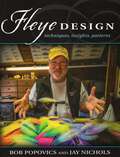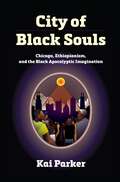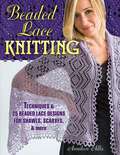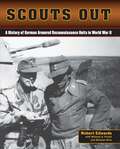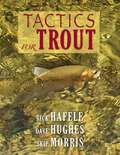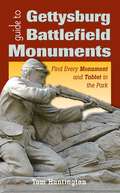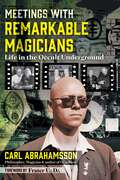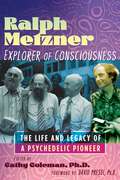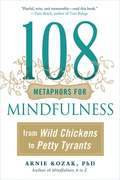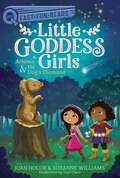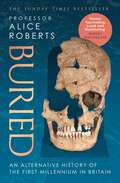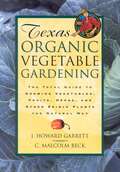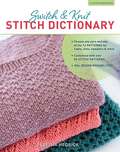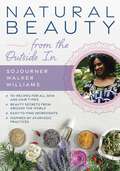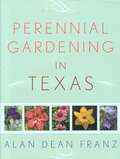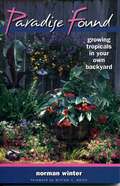- Table View
- List View
Crochet Scarves
by Sharon Hernes Silverman21 original patterns in a variety of styles, colors, yarns, stitch patterns, and techniques--including traditional crochet, Tunisian crochet, and broomstick lace crochet--for beginning through experienced crocheters
Bride's Boxes
by Pat OxenfordBasic skills for making oval boxes with traditional decorative painting.
Pocketguide to New York Hatches
by Paul WeamerDetailed hatch charts, color photos of each insect, and recipes and photos of the author's recommended fly patterns for each hatch.
Vietnam War Helicopter Art (Stackpole Military Photo Series)
by John Brennan Nicholas A. VeronicoHundreds of unique color photos showing how soldiers decorated their helicopters during the Vietnam War.
MacArthur (Stackpole Military Photo Series)
by James W. ZobelGeneral Douglas MacArthur was one of the most colorful, controversial, and image-conscious military figures of the twentieth century. This military biography in photos captures the spirit of the man and his legend in hundreds of historical images.
Vietnam War Helicopter Art (Stackpole Military Photo Series)
by Chris Evans John BrennanHundreds of unique color photos showing how soldiers decorated their helicopters during the Vietnam War.
Fleye Design
by Bob Popovics Jay NicholsIn the twelve years since his landmark book Pop Fleyes, Bob Popovics has continued to develop new fly patterns and improve old favorites. His new book includes 36 step-by-step tying and technique tutorials, over 12 new patterns, and numerous variations for every situation, plus contributions from a new generation of fly tiers who have been influenced by his signature style.
City of Black Souls: Chicago, Ethiopianism, and the Black Apocalyptic Imagination (Politics and Culture in Modern America)
by Kai ParkerHow Black Protestants in Chicago created Ethiopianism, a transnational religious movement against Western imperialismCity of Black Souls uncovers the history of how, from the late nineteenth to the mid-twentieth century, Black Protestants in Chicago created a transnational religious movement that connected the Black struggle for freedom in the United States to the global Black fight against Western imperialism. This was a movement of Ethiopianism—meaning a movement for Black religious and political independence inspired by biblical references to “Ethiopia,” particularly Psalm 68:31, “Princes shall come out of Egypt; Ethiopia shall soon stretch out her hands unto God.”Through Ethiopianism, Kai Parker argues, Black Chicago Protestants drew from Coptic and Ethiopian Orthodox Christian traditions and worked with West African Christians to imagine that Afrodiasporic Christian faith heralded the apocalyptic end of imperialism and white supremacy. Parker illuminates the apocalyptic Ethiopianism of famous Black Chicagoans such as Ida B. Wells and gospel musician Thomas Dorsey, and of lesser-known ones such as painter William Edouard Scott and Nigerian immigrant turned anticolonial missionary Samuel Wadiei Martin. When John C. Robinson, a Black Chicagoan, led Haile Selassie’s air force against Mussolini’s invasion of Ethiopia in 1935–1936, this was no coincidence, but rather an outgrowth of decades of Ethiopianism in Chicago.City of Black Souls shows that Ethiopianism was a dynamic, heterogeneous, and modern movement through which Black migrants to Chicago engaged the industrial city and influenced the mid-twentieth-century anticolonial and civil rights movements. The book is especially important to Black religious and political studies in its demonstration of how apocalyptic Ethiopianism differed in its contributions to the Black freedom struggle from the canonical “prophetic” religion grounded in the Exodus notion of moving from slavery to freedom.
Beaded Lace Knitting
by Anniken AllisCreate delicate knitted lace fashions, and then kick them up a notch with beautiful beaded embellishments, led by lace expert Anniken Allis.
Scouts Out: A History of German Armored Reconnaissance Units in World War II
by Robert J. EdwardsScouts Out is the definitive account of German armored reconnaissance in World War II, essential for historians, armor buffs, collectors, modelers, and wargamers, and the first extensive treatment of the subject in English.
Tactics for Trout
by Skip Morris Dave Hughes Rick HafeleThree well-known fly fishers (and friends) come together to share the solid technical know-how they've learned from years of fishing the ever-elusive trout.
Guide to Gettysburg Battlefield Monuments
by Tom HuntingtonWhere to find every monument and tablet on the Gettysburg Battlefield--over 800 in all--organized by state, military unit, person, or army.
Ultimate Guide to Fishing South Florida on Foot
by Steve KantnerFrom a veteran South Florida angler comes the first fly and light tackle do-it-yourself guide to the region, focusing on fishing opportunities that don't require a boat.
Meetings with Remarkable Magicians: Life in the Occult Underground
by Carl Abrahamsson• Explores the author&’s extensive connections with infamous occultists and organizations, including Genesis P-Orridge and Thee Temple Ov Psychick Youth, Anton LaVey and the Church of Satan, and the Ordo Templi Orientis• Details the underlying occult impulses and magical experiences guiding the author&’s artistic journey, his experiences in psychedelic culture and the punk subculture, and his experimentation with sex magic, occulture, and sigil magicWhat does it mean to live a life as an occultist? There may be no single answer, but for Carl Abrahamsson, it has entailed work in music, art, and film as well as deep engagement with renowned occult figures and organizations for more than 40 years.Illustrating the possibilities of a life infused with magic, Abrahamsson reflects on his decades spent in the company of some of the most unconventional thinkers of the late 20th and early 21st centuries. He reveals his involvement with psychedelic culture, the punk subculture, and numerous occult figures and organizations, including Genesis P-Orridge and Thee Temple Ov Psychick Youth, Anton LaVey&’s Church of Satan, the Ordo Templi Orientis, and a branch of the American Golden Dawn.Interwoven with his occult experiences and meetings with infamous practitioners of magic, Abrahamsson describes his evolution as a multidisciplinary artist, always imbuing his diverse artistic practice with a developing occult philosophy. He also details his ongoing efforts to disseminate the occult arts via publishing companies like Psychick Release, Looking Glass Press, Edda Publishing, Trapart Books, and the occultural journal The Fenris Wolf—as well as fieldwork in Tibet, Nepal, and India through the Institute of Comparative Magico-anthropology. Through each encounter and reflection on the magical, shamanic, and mystical practices that structured his own life, Abrahamsson illuminates how it&’s possible to experience a life of wisdom and miracles.
Ralph Metzner, Explorer of Consciousness: The Life and Legacy of a Psychedelic Pioneer
by Cathy Coleman• Includes contributions from Rick Doblin, Charles S. Grob, Stan Grof, Stanley Krippner, Dennis McKenna, the late Christian Rätsch, Richard Strozzi-Heckler, Claudia Mueller-Ebeling, Dorothy Fadiman, Luis Eduardo Luna, and others• Explores Ralph&’s childhood, his time at Harvard with Timothy Leary and Richard Alpert (Ram Dass), his work with Agni Yoga and transpersonal psychology, his development of ecopsychology, and his in-depth psychedelic researchRenowned as a pioneering psychologist, psychedelic elder, alchemical explorer, and shamanic teacher, the late Ralph Metzner (1936–2019) contributed profoundly to consciousness research, transpersonal psychology, and contemporary psychedelic studies across his more than 50-year career.Celebrating the life and legacy of Ralph Metzner, this book explores how Ralph touched the lives of those around him in extraordinary and remarkable ways, recasting people&’s worldviews and inspiring the flowering of creativity, personal growth, and spiritual transformation. There are recollections from the pivotal years of the Sixties, when Ralph conducted research with Timothy Leary and Richard Alpert (Ram Dass). Other contributors describe Ralph&’s involvement in the School of Actualism in the 1970s and the profound impact that Agni Yoga had on Ralph&’s explorations of consciousness and his healing therapies. We also learn about Ralph&’s development of Green Psychology, or ecopsychology, his mystical work exploring prenatal realms of consciousness and channeling, and his healing and transformative &“Vision Circles.&” Academic colleagues and a who&’s who of fellow psychedelic researchers share stories from their work with Ralph, illuminating his depth of knowledge and broad impact. This book paints a complete portrait of Ralph Metzner in his well-known roles as therapist and psychedelic pioneer and as an intrepid explorer of consciousness until the very end of his life.
108 Metaphors for Mindfulness: From Wild Chickens to Petty Tyrants
by Arnie KozakFrom the author of Mindfulness A to Z!This engaging and accessible little book is filled with both humor and profound teaching. It presents 108 metaphors for mindfulness, meditation practice, the nature of the self, change, deep acceptance, and other related concepts that Dr. Kozak has cultivated over twenty-five years of meditating, practicing yoga, and working as a clinical psychologist. Metaphors are indispensable to understanding mindfulness, and to help deeply internalize it and make it a part of everyday life. These mentally catchy images can motivate us to practice, show us how and where to bring mindfulness to life in our personal experience, and help us employ powerful methods for transformation. This book was previously published under the title Wild Chicken and Petty Tyrants.
Tumblebugs and Hairy Bears
by Suzanne SamsonIn this imaginative nature book, children learn about insects and are entertained with outrageous illustrations that bring them to life.Ages 6-10
Artemis & the Dog's Diamond: A QUIX Book (Little Goddess Girls #12)
by Joan Holub Suzanne WilliamsArtemis and Orion help each other on their quests in this twelfth Little Goddess Girls story—part of the Aladdin QUIX line!Artemis is on the final quest to bring the last missing jewel—a diamond—back to Zeus. She ends up in the Forest of Lost and Found, where she meets a young hunter named Orion. He&’s looking for something, too: a dog! With some extra magic and the power of friendship, can Artemis and Orion both find what they are looking for?
Targeted: The 1983 Marine Barracks Bombing and the Untold Origin Story of the War on Terror
by James M. Scott Jack CarrThe first in a new in-depth nonfiction series examining the devastating terrorist attacks that changed the course of history from #1 New York Times bestselling author Jack Carr and Pulitzer Prize finalist James M. Scott, beginning with the 1983 Marine barracks bombing in Beirut. 1983: the United States Marine Corps experiences its greatest single-day loss of life since the Battle of Iwo Jima, when a truck packed with explosives crashes into their headquarters and barracks in Beirut, Lebanon. This horrifying terrorist attack, which killed 241 servicemen, continues to influence US foreign policy and haunts the Marine Corps to this day. Now, the full story is revealed as never before by Jack Carr and historian and Pulitzer Prize finalist James M. Scott. Based on comprehensive interviews with survivors, extensive military records, as well as personal letters, diaries and photographs, this is the authoritative account of the deadly attack.
Buried: An alternative history of the first millennium in Britain
by Alice RobertsA SUNDAY TIMES BESTSELLER &‘Tender, fascinating … Lucid and illuminating&’ Robert Macfarlane Funerary rituals show us what people thought about mortality; how they felt about loss; what they believed came next. From Roman cremations and graveside feasts, to deviant burials with heads rearranged, from richly furnished Anglo Saxon graves to the first Christian burial grounds in Wales, Buried provides an alternative history of the first millennium in Britain. As she did with her pre-history of Britain in Ancestors, Professor Alice Roberts combines archaeological finds with cutting-edge DNA research and written history to shed fresh light on how people lived: by examining the stories of the dead.
Texas Organic Vegetable Gardening: The Total Guide to Growing Vegetables, Fruits, Herbs, and Other Edible Plants the Natural Way
by Howard GarrettThis book shows you how to have healthy soil and recommends environmentally safe products and even some homemade remedies to control pests and diseases in your garden. It describes more than 100 food plants and gives specific information on the growth habits, culture, harvest, and storage of each.
Switch & Knit Stitch Dictionary: Choose any yarn and any of the 12 PATTERNS for cowls, hats, sweaters & more * Customize with over 85 STITCH PATTERNS * 700+ DESIGN POSSIBILITIES
by Tabetha HedrickNow it's easy to design your own knit! Start with one of the 12 basic pattern recipes for pieces such as a hat, pullover, shawl, scarf, socks, tee, mitts, tunic, or cardigan. Choose nearly any yarn and a stitch pattern from the 85 4-stitch multiple patterns in the stitch dictionary, and you are on your way to your own unique knitted piece. Make cabled mitts, a lace cardigan, a textured stole, a ribbed pullover, or any of over 700 possible combinations. Best yet, you can knit with any yarn that works to a gauge of 3-8 stitches per inch, so you can use that perfect yarn in your stash you've been saving and design just the right project for it. It is so exciting to make your own one-of-a-kind knits, and this book makes it so easy!
Natural Beauty from the Outside In: 70+ recipes for all skin and hair types
by Sojourner Walker WilliamsTake control of what goes into your body with your own natural skin and hair care products!Our skin is our largest organ and absorbs like a sponge what is placed on the outer layer, drawing it deeper into the inner layers and dispersing it into the bloodstream. Many of the bath and beauty products we use contain toxic chemical substances, but it is easy to make your own safe, natural alternatives. Sojourner Walker Williams has been perfecting her natural beauty products for years and is trusted by her many faithful consumers. She is an Ayurvedic practitioner, yoga instructor, and wellness blogger, and in her travels has sought out natural, effective beauty solutions from around the world. In Natural Beauty From the Outside In she takes you with her on her journeys of discovery around the world. Travel with her to Thailand, where she discovers the miracles of coconut oil, and to Ghana, where she learns of the many uses of shea butter. Each chapter is devoted to a location and an important ingredient, and is full of recipes that are easy to make in your kitchen. Don't worry. You won't have to travel to find ingredients. They are all found easily in stores or online sources. Sojourner shares 75 of her most popular recipes, plus many hints for usage, storing and preserving, and sensitive skin considerations.
Perennial Gardening in Texas
by Alan Dean FranzPerennial Gardening in Texas presents its own unique challenges, especially with the state's wide variety of climate zones. This book focuses on individual plants—some 120 species—but also brings with it the expertise of a landscape architect in providing designs that will work both damp and water-scarce areas.
Paradise Found: Growing Tropicals in Your Own Backyard
by Norman WinterLoaded with plants that conjure visions of tropical islands and pina coladas, Paradise Found makes real every gardener's dream of living in a private Eden.
